Paleo-Atmospheric Precipitation Recharged to Groundwater in Middle-Latitude Deserts of Northern China
Abstract
1. Introduction
2. Regional Backgrounds
3. Theoretical Basis of Research Methods
3.1. Aerated/Vadose Zone and Chlorine Tracer
3.2. Research Progress
4. Data Sources
5. Analytical Results
5.1. General Characteristics of Desert Unsaturated Zone Profiles
5.2. Calculation of Steady-State Parameters and Estimation of Average Recharge Rate of the Vadose Zone
6. Discussion
6.1. Chronological Sequence of Unsaturated Zone Profile and Its Environmental Indication
6.2. Comparison between Unsaturated Zone and Other Proxy Records
6.3. Uncertainty of Atmospheric Precipitation Recharge Records in Unsaturated Zones
6.4. A Controversial Issue: The Sources of Groundwater in the Alashan Plateau
7. Conclusions
Funding
Institutional Review Board Statement
Informed Consent Statement
Data Availability Statement
Acknowledgments
Conflicts of Interest
References
- Yao, T.; Thompson, L. Trends and features of climatic changes in the past 5000 years recorded by the Dunde ice core. Ann. Glaciol. 1991, 16, 21–24. [Google Scholar]
- Thompson, L.; Mosley-Thompson, E.; Davis, M.E.; Lin, P.; Dai, J.; Bolzan, J.; Yao, T. A 1000 year climatic icecore record from the Guliya ice cap, China: Its relationship to global climate variability. Ann. Glaciol. 1995, 21, 175–181. [Google Scholar] [CrossRef]
- Thompson, L.O.; Yao, T.; Davis, M.E.; Henderson, K.A.; Mosley-Thompson, E.; Lin, P.N.; Beer, J.; Synal, H.A. Tropical climate instability: The last glacial cycle from a Qinghai-Tibet ice core. Science 1997, 276, 1821–1825. [Google Scholar] [CrossRef]
- Sheppard, P.R.; Tarasov, P.E.; Graumlich, L.J.; Heussner, K.U.; Wagner, M.; Österle, H.; Thompson, L.G. Annual precipitation since 515 BC reconstructed from living and fossil juniper growth of northeastern Qinghai Province, China. Clim. Dyn. 2004, 23, 869–881. [Google Scholar] [CrossRef]
- Shao, X.; Huang, L.; Liu, H.; Liang, E.Y.; Fang, X.Q.; Wang, L.L. Reconstruction of precipitation variation from tree rings in recent 1000 years in Delingha, Qinghai. Sci. China (Ser. D) 2005, 48, 939–949. [Google Scholar] [CrossRef]
- Liu, H.B.; Shao, X.M.; Huang, L.; Liang, E.Y.; Fang, X.; Wang, L. Statistical characteristics of annual precipitation variation during the past 1000 years in Delingha, Qinghai Province, China. Quat. Sci. 2005, 25, 176–183. [Google Scholar]
- Huang, L.; Shao, X.M. Precipitation variation in Delingha, Qinghai and solar activity since last 400 years. Quat. Sci. 2005, 25, 184–192. [Google Scholar]
- Liya, J.; Ningsheng, Q.; Xiaohua, G. Series of spring maximum temperature in Southern Qinghai Plateau and analysis of its variations during the last 450 years. Quat. Sci. 2005, 25, 193–201. [Google Scholar]
- Liya, J.; Ningsheng, Q.; Xiaohua, G. A 3500-year master tree-ring dating chronology from the northeastern part of the Qaidam Basin. Quat. Sci. 2007, 27, 477–485. [Google Scholar]
- Gou, X.H.; Yang, M.X.; Peng, J.F.; Zhang, Y.; Chen, T.; Hou, Z. Maximum temperature reconstruction for Animaqing Mountains over past 830 years based on tree-ring records. Quat. Sci. 2006, 26, 991–998. [Google Scholar]
- Wang, Y.; Ma, Y.; Lu, R.; Sang, Y.L.; Meng, H.W.; Hua, F.C.; Man, Z.H. Reconstruction of mean temperatures of January to August since A.D.1895 based on tree ring data in the eastern part of the Qilian Mountains. Quat. Sci. 2009, 29, 905–912. [Google Scholar]
- Bao, Y. Spatial and temporal patterns of climate variations over the Tibetan Plateau during the period 1300–2010. Quat. Sci. 2012, 32, 81–94. [Google Scholar]
- Yu, L.; Qiufang, C.; Huiming, S. Seasonal and spatial representativeness of the tree-ring based 2485-year annual mean temperature reconstruction in the northeastern Tibetan Plateau. Quat. Sci. 2013, 33, 108–114. [Google Scholar]
- Zhang, T.W.; Liu, Y.; Yuan, Y.J.; Wei, W.S.; Yu, S.L.; Chen, F. Tree ring based mean maximum temperature reconstruction for the Gongnaisi region on the southern slopeof the central Tienshan mountain, China since AD 1777. Quat. Sci. 2011, 31, 1011–1021. [Google Scholar]
- Wenshou, W.; Feng, C. Tree-ring reconstruction of annual total runoff for the Ürümqi River on the northern slope of Tien Shan Mountains. Quat. Sci. 2013, 33, 501–510. [Google Scholar]
- Shi, X.; Qin, N.; Liu, H.; Wang, Q.; Feng, S.; Liu, Y. Surface heating field intensity change over Tibetan Plateau recorded Qinghai Zhiduo tree rings since 1374 A.D. Quat. Sci. 2013, 33, 115–125. [Google Scholar]
- Zhang, J.; Jin, M.; Chen, F.; Battarbee, R.W.; Henderson, A.C.G. High-resolution precipitation variations in the northeast Tibetan Plateau over the last 800 years documented by sediment cores of Qinghai Lake. Chin. Sci. Bull. 2003, 48, 1451–1456. [Google Scholar] [CrossRef]
- Zhang, H.C.; Peng, J.L.; Ma, Y.Z.; Chen, G.J.; Feng, Z.D.; Li, B.; Fan, H.; Chang, F.; Lei, G.; Wünnemann, B. Late Quaternary palaeolake levels in Tengger Desert. Palaeogeogr. Palaeoclimatol. Palaeoecol. 2004, 211, 45–58. [Google Scholar] [CrossRef]
- Herzschuh, U.; Kürschner, H.; Battarbee, R.; Holmes, J. Desert plant pollen production and a 160-year record of vegetation and climate change on the Alashan Plateau, NW China. Veg. Hist. Archaeobot. 2006, 15, 181–190. [Google Scholar] [CrossRef]
- Ji, S.; Enlou, Z. Records from lakes sediments of the Qinghai Lake to Mirror climatic and environmental changes of the past about 1000 years. Quat. Sci. 2001, 21, 508–513. [Google Scholar]
- Liping, Z. Cold/warm fluctuations of the last 1300 years reflected by environmental magnetism in the Chen Co area, Southern Tibet. Quat. Sci. 2001, 21, 520–527. [Google Scholar]
- Jibin, X.; Wei, Z. Holocene climate change recorded by lacustrine sediments in Barkol Lake and its regional comparison. Quat. Sci. 2008, 28, 610–620. [Google Scholar]
- Wangning, L.W.; Liming, X. Oxygen isotopic compositions of carbonates of modern surface lacustrine sediments and their affecting factors in Tibet Plateau. Quat. Sci. 2008, 28, 591–600. [Google Scholar]
- Cao, J.; Zhang, J.W.; Zhang, C.J.; Chen, F. Environmental changes during the past 800 years recorded in lake sediments from Hala Lake on the Northern Tibetan Plateau. Quat. Sci. 2007, 27, 100–107. [Google Scholar]
- Yang, X. Landscape evolution and precipitation changes in the Badain Jaran Desert during the last 30,000 years. Chin. Sci. Bull. 2000, 45, 1042–1047. [Google Scholar] [CrossRef]
- Zhang, J.; Crowley, T.J. Historical climate records in China and reconstruction of past climates. J. Clim. 1989, 2, 833–849. [Google Scholar] [CrossRef]
- Gong, G.; Hameed, S. The variation of moisture conditions in China during the last 2000 years. Int. J. Climatol. 1991, 11, 271–283. [Google Scholar] [CrossRef]
- Feng, Z.; An, C.; Wang, H. Holocene climatic and environmental changes in the arid and semi-arid areas of China: A review. Holocene 2006, 16, 119–130. [Google Scholar] [CrossRef]
- Ding, Y.; Chan, J.C.L. The East Asian summer monsoon: An overview. Meteorol. Atmos. Phys. 2005, 89, 117–142. [Google Scholar]
- Yang, X.; Williams, M.A.J. The ion chemistry of lakes and late Holocene desiccation in the Badain Jaran Desert, Inner Mongolia, China. Catena 2003, 51, 45–60. [Google Scholar] [CrossRef]
- Xiaoping, Y.; Tunsheng, L. Palaeoenvironments in desert regions of northwest China around 30 ka B.P. Quat. Sci. 2003, 23, 25–30. [Google Scholar]
- Yang, X.; Rost, K.T.; Lehmkuhl, F.; Zhenda, Z.; Dodson, J. The evolution of dry lands in Northern China and in the Republic of Mongolia since the Last Glacial Maximum. Quat. Int. 2004, 118–119, 69–85. [Google Scholar] [CrossRef]
- Yang, X.; Scuderi, L.A. Hydrological and climatic changes in deserts of China since the Late Pleistocene. Quat. Res. 2010, 73, 1–9. [Google Scholar] [CrossRef]
- Shi, Q.; Chen, F.H.; Zhu, Y.; Madsen, D. Lake evolution of the terminal area of Shiyang River drainage in arid China since the last glaciation. Quat. Int. 2002, 93–94, 31–34. [Google Scholar] [CrossRef]
- An, C.; Feng, Z.; Barton, L. Dry or humid? Mid Holocene humidity changes in arid and semi-arid China. Quat. Sci. Rev. 2006, 25, 351–361. [Google Scholar] [CrossRef]
- Gao, Q.; Tao, Z.; Li, B.; Jin, H.; Zou, X.; Zhang, Y.; Dong, G. Palaeomonsoon variability in the southern fringe of the Badain Jaran Desert, China, since 130 ka BP. Earth Surf. Process. Landf. 2006, 31, 265–283. [Google Scholar] [CrossRef]
- Yang, X.; Scuderi, L.; Paillou, P.; Liu, Z.; Li, H.; Ren, X. Quaternary environmental changes in the drylands of China—A critical review. Quat. Sci. Rev. 2011, 30, 3219–3233. [Google Scholar] [CrossRef]
- Zongyu, C.; Jixiang, Q.; Jianming, X.; Jiaming, X.; Hao, Y.; Yunju, N. Paleoclimatic interpretation of the past 30 ka from isotopic studies of the deep confined aquifer of the North China plain. Appl. Geochem. 2003, 18, 997–1009. [Google Scholar] [CrossRef]
- Edmunds, W.M.; Ma, J.; Aeschbach-Hertig, W. Groundwater recharge history and hydrogeochemical evolution in the Minqin Basin, north west China. Appl. Geochem. 2006, 21, 2148–2170. [Google Scholar] [CrossRef]
- Chen, J.S.; Li, L.; Wang, J.Y.; Barry, D.A.; Sheng, X.F.; Gu, W.Z.; Zhao, X.; Chen, L. Groundwater maintains dune landscape. Nature 2004, 432, 459–460. [Google Scholar] [CrossRef]
- Ma, J.; Ding, Z.; Edmunds, W.M.; Gates, J.B.; Huang, T. Limits or recharge of groundwater from Tibetan Plateau to the Gobi Desert, implications for water management in the mountain front. J. Hydrol. 2009, 364, 128–141. [Google Scholar] [CrossRef]
- Jäkel, D. The importance of dunes for groundwater recharge and storage in China. Z. Geomorphol. Neues Funde Suppl. 2002, 126, 131–146. [Google Scholar]
- Ma, J.; Li, D.; Zhang, J.; Edmunds, W.M.; Prudhomme, C. Groundwater recharge and climatic change during the last 1000 years from unsaturated zone of SE Badain Jaran Desert. Chin. Sci. Bull. 2003, 48, 1469–1474. [Google Scholar] [CrossRef]
- Ma, J.; Edmunds, W.M.; He, J.; Jia, B. A 2000 year geochemical record of palaeoclimate and hydrology derived from dune sand moisture. Palaeogeogr. Palaeoclimatol. Palaeoecol. 2009, 276, 38–46. [Google Scholar] [CrossRef]
- Ma, J.; Pan, F.; Chen, L.; Edmunds, W.M.; Ding, Z.; He, J.; Zhou, K.; Huang, T. Isotopic and geochemical evidence of recharge sources and water quality in the Quaternary aquifer beneath Jinchang City, NW China. Appl. Geochem. 2010, 25, 996–1007. [Google Scholar] [CrossRef]
- Ma, J.; Wang, Y.; Zhao, Y.; Jin, X.; Ning, N.; Edmunds, W.M.; Zhou, X. Spatial distribution of chloride and nitrate within an unsaturated dune sand of a cold-arid desert: Implications for paleoenvironmental records. Catena 2012, 96, 68–75. [Google Scholar] [CrossRef]
- Ma, J.; He, J.; Qi, S.; Zhu, G.; Zhao, W.; Edmunds, W.M.; Zhao, Y. Groundwater recharge and evolution in the Dunhuang Basin, Northwestern China. Appl. Geochem. 2013, 28, 19–31. [Google Scholar] [CrossRef]
- Yang, X.; Ma, N.; Dong, J.; Zhu, B.; Xu, B.; Ma, Z.; Liu, J. Recharge to the inter-dune lakes and Holocene climatic changes in the Badain Jaran Desert, western China. Quat. Res. 2010, 73, 10–19. [Google Scholar] [CrossRef]
- Chen, Z.; Nie, Z.; Zhang, G.; Wan, L.; Shen, J. Environmental isotopic study on the recharge and residence time of groundwater in the Heihe River Basin, Northwestern China. Hydrogeol. J. 2006, 14, 1635–1651. [Google Scholar] [CrossRef]
- Lin, R.; Wei, K. Tritium profiles of pore water in the Chinese loess unsaturated zone: Implications for estimation of groundwater recharge. J. Hydrol. 2006, 328, 192–199. [Google Scholar] [CrossRef]
- Ma, J.; Edmunds, W.M. Groundwater and lake evolution in the Badain Jaran desert ecosystem, Inner Mongolia. Hydrogeol. J. 2006, 14, 1231–1243. [Google Scholar] [CrossRef]
- Gates, J.B.; Edmunds, W.M.; Ma, J.; Scanlon, B.R. Estimating groundwater recharge in a cold desert environment in Northern China using chloride. Hydrogeol. J. 2008, 16, 893–910. [Google Scholar] [CrossRef]
- Gates, J.B.; Edmunds, W.M.; Ma, J.; Sheppard, P.R. A 700-year history of groundwater recharge in the drylands of NW China. Holocene 2008, 18, 1045–1054. [Google Scholar] [CrossRef]
- Gates, J.B.; Edmunds, W.M.; Darling, W.G.; Ma, J.; Pang, Z.; Young, A.A. Conceptual model of recharge to southeastern Badain Jaran Desert groundwater and lakes from environmental tracers. Appl. Geochem. 2008, 23, 3519–3534. [Google Scholar] [CrossRef]
- Huang, T.; Pang, Z. Estimating groundwater recharge following land-use change using chloride mass balance of soil profiles: A case study at Guyuan and Xifeng in the Loess Plateau of China. Hydrogeol. J. 2011, 19, 177–186. [Google Scholar] [CrossRef]
- Huang, T.; Pang, Z.; Edmunds, W.M. Soil profile evolution following land-use change: Implications for groundwater quantity and quality. Hydrol. Process. 2013, 27, 1238–1252. [Google Scholar] [CrossRef]
- Yang, X. Water chemistry of the lakes in the Badain Jaran Desert and their Holocene evolutions. Quat. Sci. 2002, 22, 97–104. [Google Scholar]
- Nina, M.; Xiaoping, Y. Environmental isotopes and ion chemistry in the Badain Jaran Desert, Inner Mongolia and their implications. Quat. Sci. 2008, 28, 702–711. [Google Scholar]
- Feng, H.; Lu, H.Y.; Yi, S.W.; Zeng, L.; Qiu, Z.M.; Cui, M.C. The border changes of the deserts/sand field in the East Asian monsoon marginal region during Last Glacial Maximum and Holocene Optimum. Quat. Sci. 2013, 33, 252–259. [Google Scholar]
- Yu, K.; Lu, H.; Lehmkuhl, F. A preliminary quantitative paleoclimate reconstruction of the Last Glacial Maximum and Holocene Optimum in dune fields of Northern China. Quat. Sci. 2013, 33, 293–302. [Google Scholar]
- Ma, J.Z.; Ding, Z.; Gates, J.B.; Su, Y. Chloride and the environmental isotopes as the indicators of the groundwater recharge in the Gobi Desert, Northwest China. Environ. Geol. 2008, 55, 1407–1419. [Google Scholar] [CrossRef]
- Ma, L. Geological Atlas of China; Geological Press: Beijing, China, 2002. [Google Scholar]
- Winograd, I.J.; Robertson, F.N. Deep oxygenated groundwater: Anomaly or common occurrence? Science 1982, 216, 1227–1230. [Google Scholar] [CrossRef] [PubMed]
- Cook, P.G.; Edmunds, W.M.; Gaye, C.B. Estimating paleorecharge and paleoclimate from unsaturated zone profiles. Water Resour. Res. 1992, 28, 2721–2731. [Google Scholar] [CrossRef]
- Beyerle, U.; Rueedi, J.; Leuenberger, M.; Aeschbach-Hertig, W.; Peeters, F.; Kipfer, R.; Dodo, A. Evidence for periods of wetter and cooler climate in the Sahel between 6 and 40 kyr BP derived from groundwater. Geophys. Res. Lett. 2003, 30, 1173. [Google Scholar] [CrossRef]
- Edmunds, W.M.; Guendouz, A.H.; Mamou, A.; Moulla, A.; Shand, P.; Zouari, K. Groundwater evolution in the Continental Intercalaire aquifer of Southern Algeria and Tunisia: Trace element and isotopic indicators. Appl. Geochem. 2003, 18, 805–822. [Google Scholar] [CrossRef]
- Ma, J.; Wang, X.; Edmunds, W.M. The characteristics of groundwater resources and their changes under the impacts of human activity in the arid North-West China—A case study of the Shiyang River Basin. J. Arid. Environ. 2005, 61, 277–295. [Google Scholar] [CrossRef]
- Scanlon, B.R.; Tyler, S.W.; Wierenga, P.J. Hydrologic issues in arid, unsaturated systems and implication for contaminant transport. Rev. Geophys. 1997, 35, 461–490. [Google Scholar] [CrossRef]
- Allison, G.B.; Hughes, M.W. The use of natural tracers as indicators of soil-water movement in a temperate semi-arid region. J. Hydrol. 1983, 60, 157–173. [Google Scholar] [CrossRef]
- Scanlon, B.R. Evaluation of moisture flux from chloride data in desert soils. J. Hydrol. 1991, 128, 137–156. [Google Scholar] [CrossRef]
- Scanlon, B.R.; Healy, R.W.; Cook, P.G. Choosing appropriate techniques for quantifying groundwater recharge. Hydrogeol. J. 2002, 10, 18–39. [Google Scholar] [CrossRef]
- Ng GH, C.; McLaughlin, D.; Entekhabi, D.; Scanlon, B. Using data assimilation to identify diffuse recharge mechanisms from chemical and physical data in the unsaturated zone. Water Resour. Res. 2009, 45, W09409. [Google Scholar] [CrossRef]
- Allison, G.B.; Stone, W.J.; Hughes, M.W. Recharge in karst and dune elements of a semi-arid landscape as indicated by natural isotopes and chloride. J. Hydrol. 1985, 76, 1–25. [Google Scholar] [CrossRef]
- Tyler, S.W.; Chapman, J.B.; Conrad, S.H.; Hammermeister, D.P.; Blout, D.O.; Miller, J.J.; Sully, M.J.; Ginanni, J.M. Soil-water flux in the southern Great Basin, United States: Temporal and spatial variations over the last 120,000 years. Water Resour. Res. 1996, 32, 1481–1499. [Google Scholar] [CrossRef]
- Scanlon, B.R. Uncertainties in estimating water fluxes and residence times using environmental tracers in an arid unsaturated zone. Water Resour. Res. 2000, 36, 395–409. [Google Scholar] [CrossRef]
- Edmunds, W.M.; Tyler, S.W. Unsaturated zone as archives of past climates: Toward a new proxy for continental regions. Hydrogeol. J. 2002, 10, 216–228. [Google Scholar] [CrossRef]
- Allison, G.B.; Hughes, M.W. The use of environmental chloride and tritium to estimate total recharge to an unconfined aquifer. Austrian J. Soil Res. 1978, 16, 181–195. [Google Scholar] [CrossRef]
- Ross, B. A conceptual model of deep unsaturated zones with negligible recharge. Water Resour. Res. 1984, 20, 1627–1629. [Google Scholar] [CrossRef]
- Walvoord, M.A.; Plummer, M.A.; Phillips, F.M.; Wolfsberg, A.V. Deep arid system hydrodynamics 1. Equilibrium states and response times in thick desert vadose zones. Water Resour. Res. 2002, 38, 1308. [Google Scholar] [CrossRef]
- Scanlon, B.R.; Keese, K.; Reedy, R.C.; Simunek, J.; Andraski, B.J. Variations in flow and transport in thick desert vadose zones in response to paleoclimatic forcing (0–90 kyr): Field measurements, modeling, and uncertainties. Water Resour. Res. 2003, 39, 1179. [Google Scholar] [CrossRef]
- Hem, J.D. Study and Interpretation of the Chemical Characteristics of Natural Water; US Geological Survey Water Supply: New York, NY, USA, 1985.
- Feth, J.H. Chloride in Natural Continental Water—A Review; US Geological Survey Water Supply: New York, NY, USA, 1981.
- Lehmann, B.E.; Love, A.; Purtschert, R.; Collon, P.; Loosli, H.H.; Kutschera, W.; Beyerle, U.; Aeschbach, W.; Kipfer, R.; Frape, S.K.; et al. A comparison of groundwater dating with 81Kr, 36Cl and 4He in four wells of the Great Artesian Basin, Australia. Earth Planet. Sci. Lett. 2003, 211, 237–250. [Google Scholar] [CrossRef]
- Dettinger, M.D. Reconnaissance estimates of natural recharge to desert basins in Nevada, USA., by using chloride balance calculations. J. Hydrol. 1989, 106, 55–78. [Google Scholar] [CrossRef]
- Selaolo, E.; Gieske, A.; Beekman, H. Chloride Deposition and Recharge Rates for Shallow Groundwater Basins in Botswana. In National Conference Publication; Institute of Engineers: Barton, Australia, 1994; pp. 501–506. [Google Scholar]
- Zhu, B.; Yang, X. The origin and distribution of soluble salts in the sand seas of northern China. Geomorphology 2010, 123, 232–242. [Google Scholar] [CrossRef]
- Ginn, T.R.; Murphy, E.M. A transient flux model for convection infiltration: Forward and inverse solution for chloride mass balance studies. Water Resour. Res. 1997, 33, 2065–2079. [Google Scholar] [CrossRef]
- Phillips, F.M.; Mattick, J.L.; Duval, T.A.; Elmore, D.; Kubik, P.W. Chlorine 36 and tritium from nuclear weapons fallout as tracers for long-term liquid and vapor movement in desert soils. Water Resour. Res. 1988, 24, 1877–1891. [Google Scholar] [CrossRef]
- Sukhija, B.S.; Shah, C.R. Conformity of groundwater recharge rate by tritium method and mathematical modeling. J. Hydrol. 1976, 30, 167–178. [Google Scholar] [CrossRef]
- Dincer, T.; AI-Mugrin, A.; Zimmerman, U. Study of the infiltration and recharge through the sand dunes in arid zones with special reference to the stable isotopes and thermonuclear tritium. J. Hydrol. 1974, 23, 79–109. [Google Scholar] [CrossRef]
- Smith, B.D.; Wearn, P.L.; Richards, H.J.; Rowe, P.C. Water Movement in the Unsaturated Zone of High and Low Permeability Strata by Measuring Natural Tritium; Isotope and Hydrology Processes Symposium: Vienna, Austria, 1970; pp. 73–87. [Google Scholar]
- Zimmermann, U.; Munnich, K.O.; Roether, W. Downward movement of soil moisture traced by means of hydrogen isotopes. Geophys. Monogr. Am. Geophys. Union 1967, 11, 28–36. [Google Scholar]
- Eriksson, E.; Khunakasem, V. Chloride concentration in groundwater, recharge rate and rate of deposition of chloride in the Israel Coastal Plain. J. Hydrol. 1969, 7, 178–197. [Google Scholar] [CrossRef]
- Edmunds, W.M.; Walton, N.R.G. A geochemical and isotopic approach to recharge evaluation in semi-arid zones, past and present. In Arid Zone Hydrology, Investigations with Isotope Techniques; International Atomic Energy Agency: Vienna, Austria, 1980; pp. 47–68. [Google Scholar]
- Kitching, R.; Edmunds, W.M.; Shearer, T.R.; Walton, R.G.; Jacovides, J. Assessment of recharge to aquifers. Hydrol. Sci. Bull. 1980, 25, 217–235. [Google Scholar] [CrossRef]
- Nativ, R.; Eilan, A.; Ofer, D.; Geyh, M. Water recharge and solute transport through the vadose zone of fractured chalk under desert conditions. Water Resour. Res. 1995, 31, 253–261. [Google Scholar] [CrossRef]
- Gaye, C.B.; Edmunds, W.M. Groundwater recharge estimation using chloride, stable isotopes and tritium profiles in the sands of northwestern Senegal. Environ. Geol. 1996, 27, 246–251. [Google Scholar] [CrossRef]
- Jolly, I.D.; Cook, P.G.; Allison, G.B.; Hughes, M.W. Simultaneous water and solute movement through an unsaturated soil following an increase in recharge. J. Hydrol. 1989, 111, 391–396. [Google Scholar] [CrossRef]
- Edmunds, W.M.; Gaye, C.B. Estimating the spatial variability of groundwater recharge in the Sahel using chloride. J. Hydrol. 1994, 156, 47–59. [Google Scholar] [CrossRef]
- Bromley, J.; Edmunds, W.M.; Fellman, E.; Brouwer, J.; Gaze, S.R.; Sudlow, J.; Taupin, J.D. Estimation of rainfall inputs and direct recharge to the deep unsaturated zone of southern Niger using the chloride profile method. J. Hydrol. 1997, 188–189, 139–154. [Google Scholar] [CrossRef]
- De Vries, J.J.; Selaolo, E.T.; Beekman, H.E. Groundwater recharge in the Kalahari, with reference to paleo-hydrologic conditions. J. Hydrol. 2000, 238, 110–123. [Google Scholar] [CrossRef]
- Joshi, B.; Maule, C. Simple analytical models for interpretation of environmental tracer profiles in the vadose zone. Hydrol. Process. 2000, 14, 1503–1521. [Google Scholar] [CrossRef]
- Walvoord, M.A.; Phillips, F.M.; Stonestrom, D.A.; Evans, R.D.; Hartsough, P.C.; Newman, B.D.; Striegl, R.G. A reservoir of nitrate beneath desert soils. Science 2003, 302, 1021–1024. [Google Scholar] [CrossRef]
- Phillips, F.M. Environmental tracers for water movement in desert soils of the American Southwest. Soil Sci. Soc. Am. J. 1994, 58, 14–24. [Google Scholar] [CrossRef]
- Edmunds, W.M.; Gaye, C.B.; Fontes, J.C. A record of climatic and environmental change contained in the interstitial waters from the unsaturated zone of northern Senegal. In International Symposium on Isotope Techniques in Water Resources Development; International Atomic Energy Agency: Vienna, Austria, 1992. [Google Scholar]
- Stone, W.J. Paleohydrologic implications of some deep soil water chloride profiles, Murray Basin, South Australia. J. Hydrol. 1992, 132, 201–223. [Google Scholar] [CrossRef]
- Goni, I.B.; Fellman, E.; Edmunds, W.M. Rainfall geochemistry in the Sahel region of northern Nigeria. Atmos. Environ. 2001, 35, 4331–4339. [Google Scholar] [CrossRef]
- EANET, Network Center for 2006 EANET Data on the Acid Deposition in the East Asian Region in 2006. Acid Deposition Monitoring Network in East Asia. Available online: http://www.eanet.cc/ (accessed on 1 June 2007).
- Sheppard, P.; Holmes, R.; Graumlich, L. The ‘many fragments curse’: A special case of the segment length curse. Tree-Ring Bull. 1997, 54, 1–9. [Google Scholar]
- SMAC (State Meteorological Administration of China). Annals of 510 Years’ Precipitation Record in China; The Meteorological Research Institute: Tsukuba, Japan, 1981; p. 216.
- Hameed, S.; Yeh, W.M.; Li, M.T.; Cess, R.D.; Wang, W.C. An analysis of periodicities in the 1470–1974 Beijing precipitation record. Geophys. Res. Lett. 1983, 10, 436–439. [Google Scholar] [CrossRef]
- Scanlon, B.R.; Keese, K.E.; Flint, A.L.; Flint, L.E.; Gaye, C.B.; Edmunds, W.M.; Simmers, I. Global synthesis of groundwater recharge in semiarid and arid regions. Hydrol. Process. 2006, 20, 3335–3370. [Google Scholar] [CrossRef]
- Lotsch, A.; Friedl, M.A.; Anderson, B.T.; Tucker, C.J. Coupled vegetation–precipitation variability observed from satellite and climate records. Geophys. Res. Lett. 2003, 30, 1774. [Google Scholar] [CrossRef]
- IPCC. Climate Change 2007—The Physical Science Basis. Contribution of Working Group II to the Fourth Assessment Report of the Intergovernment Panel on Climate Change; Cambridge University Press: Cambridge, UK; New York, NY, USA, 2007. [Google Scholar]
- Hofmann, J. Geoökologische Untersuchungen der Gewässer im Südosten der Badain Jaran Wüste [Geoecological studies of the waters of the southeastern Badain Jaran Desert]. Berl. Geogr. Abhandl 1999, 64, 1–247. [Google Scholar]
- Jiansheng, C.; Xixi, C.; Ting, W. Isotopes tracer research of wet sand layer water souces in Alxa Desert. Adv. Water Sci. 2014, 25, 196–206. [Google Scholar]
- Deevey, E.S.; Cross, M.S.; Hutchinson, G.E. The natural 14C contents of materials from hard-water lakes. Proc. Natl. Acad. Sci. USA 1954, 40, 285–288. [Google Scholar] [CrossRef]
- Liu, Z.; Yang, X.; Zhu, B. Reinterpretation of the chronological data of palaeo-environmental records in the Badain Jaran Desert and reconstruction of the Holocene climatic changes. Quat. Sci. 2010, 30, 925–933. [Google Scholar]
- Hou, J.; William, J.; Andrea, D.; Liu, Z. Geochronological limitations for interpreting the paleoclimatic history of the Tibetan Plateau. Quat. Sci. 2012, 32, 441–453. [Google Scholar]
- Lauterbach, S.; Witt, R.; Plessen, B.; Dulski, P.; Prasad, S.; Mingram, J.; Gleixner, G.; Hettler-Riedel, S.; Stebich, M. Bernhard Schnetger Climatic imprint of the mid-latitude westerlies in the central Tian Shan of Kyrgyzstan and teleconnections to North Atlantic climate variability during the last 6000 years. Holocene 2014, 24, 970–984. [Google Scholar] [CrossRef]
- Chen, F.; Wu, W.; Holmes, J.A.; Madsen, D.B.; Zhu, Y.; Jin, M.; Oviatt, C.G. A mid-Holocene drought interval as evidenced by lake desiccation in the Alashan Plateau, Inner Mongolia, China. Chin. Sci. Bull. 2003, 48, 1401–1410. [Google Scholar] [CrossRef]
- Chen, F.; Yu, Z.; Yang, M.; Ito, E.; Wang, S.; Madsen, D.B.; Huang, X.; Zhao, Y.; Sato, T.; Birks, H.J.B. Holocene moisture evolution in arid central Asia and its out-of-phase relationship with Asian monsoon history. Quat. Sci. Rev. 2008, 27, 351–364. [Google Scholar] [CrossRef]
- Hartmann, K.; Wünnemann, B. Hydrological changes and Holocene climate variations in NW China, inferred from lake sediments of Juyanze palaeolake by factor analyses. Quat. Int. 2009, 194, 28–44. [Google Scholar] [CrossRef]
- Zhu, B.; Yang, X.; Liu, Z.; Rioual, P.; Li, C.; Xiong, H. Geochemical compositions of soluble salts in aeolian sands from the Taklamakan and Badanjilin deserts in Northern China, and their influencing factors and environmental implications. Environ. Earth Sci. 2012, 66, 337–353. [Google Scholar] [CrossRef]
- Zhu, B.; Yang, X.; Rioual, P.; Liu, Z.; Li, C.; Xiong, H. Compositions of soluble salts in aeolian sands from sandy deserts of Northern China and their environmental implications. Quat. Sci. 2011, 31, 1029–1044. [Google Scholar]
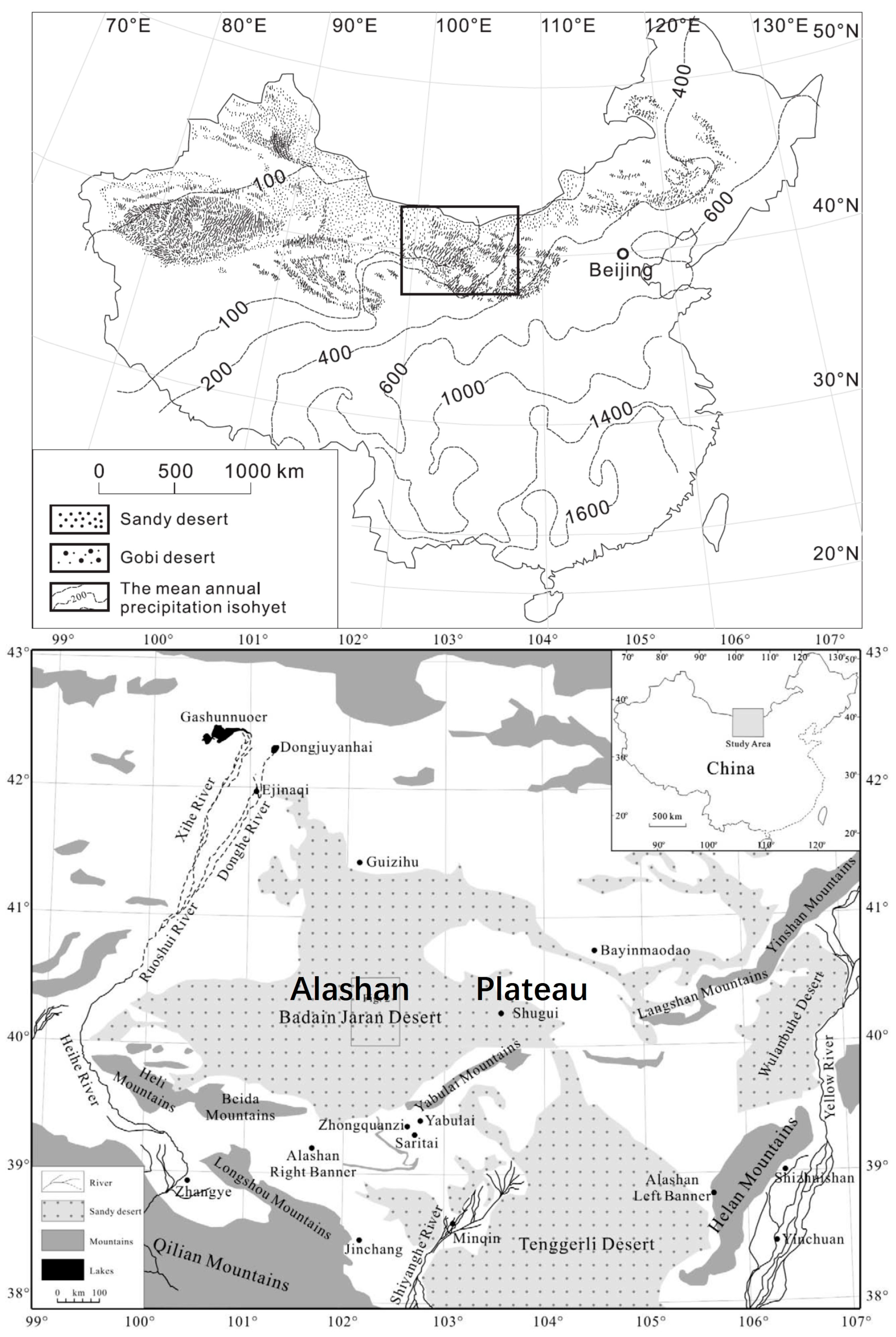
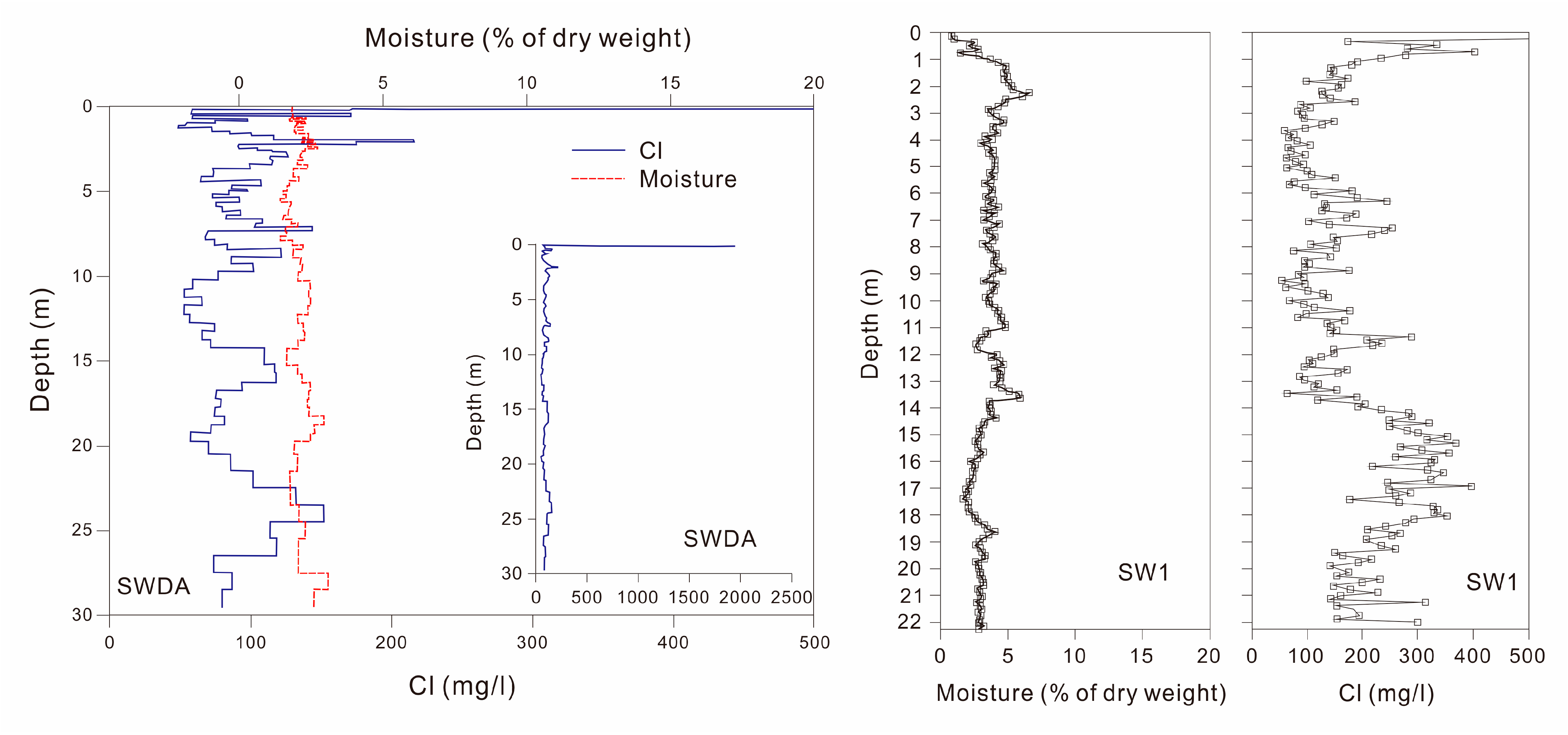
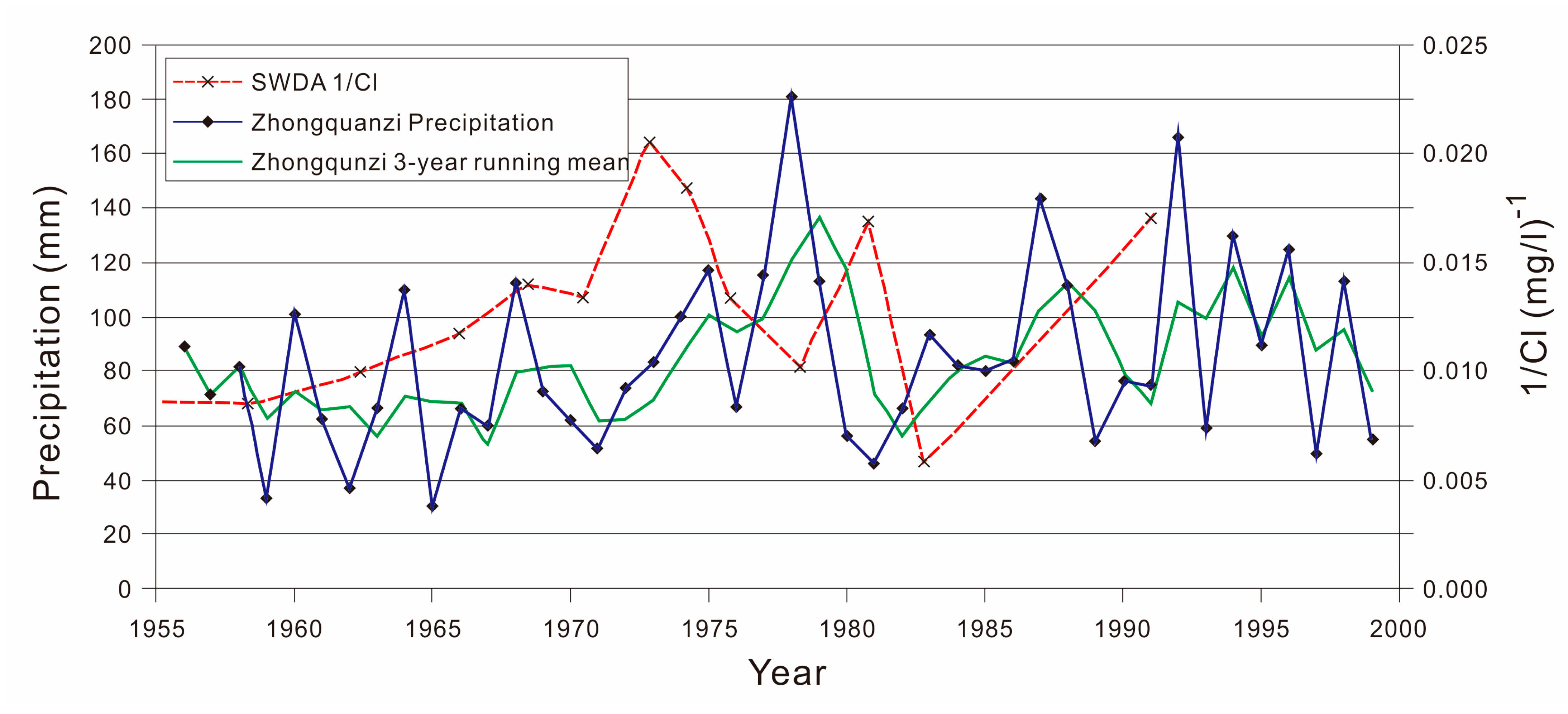
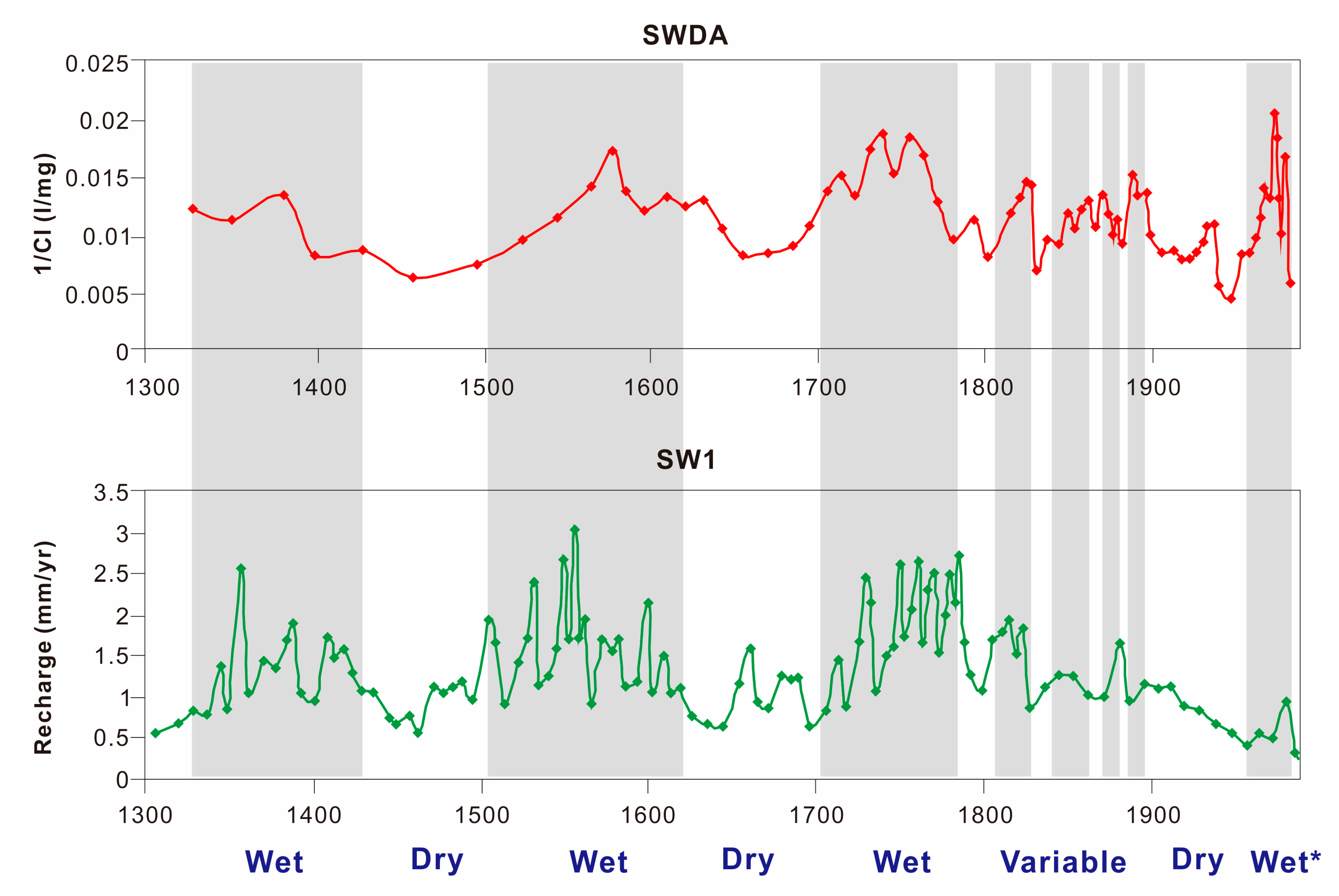
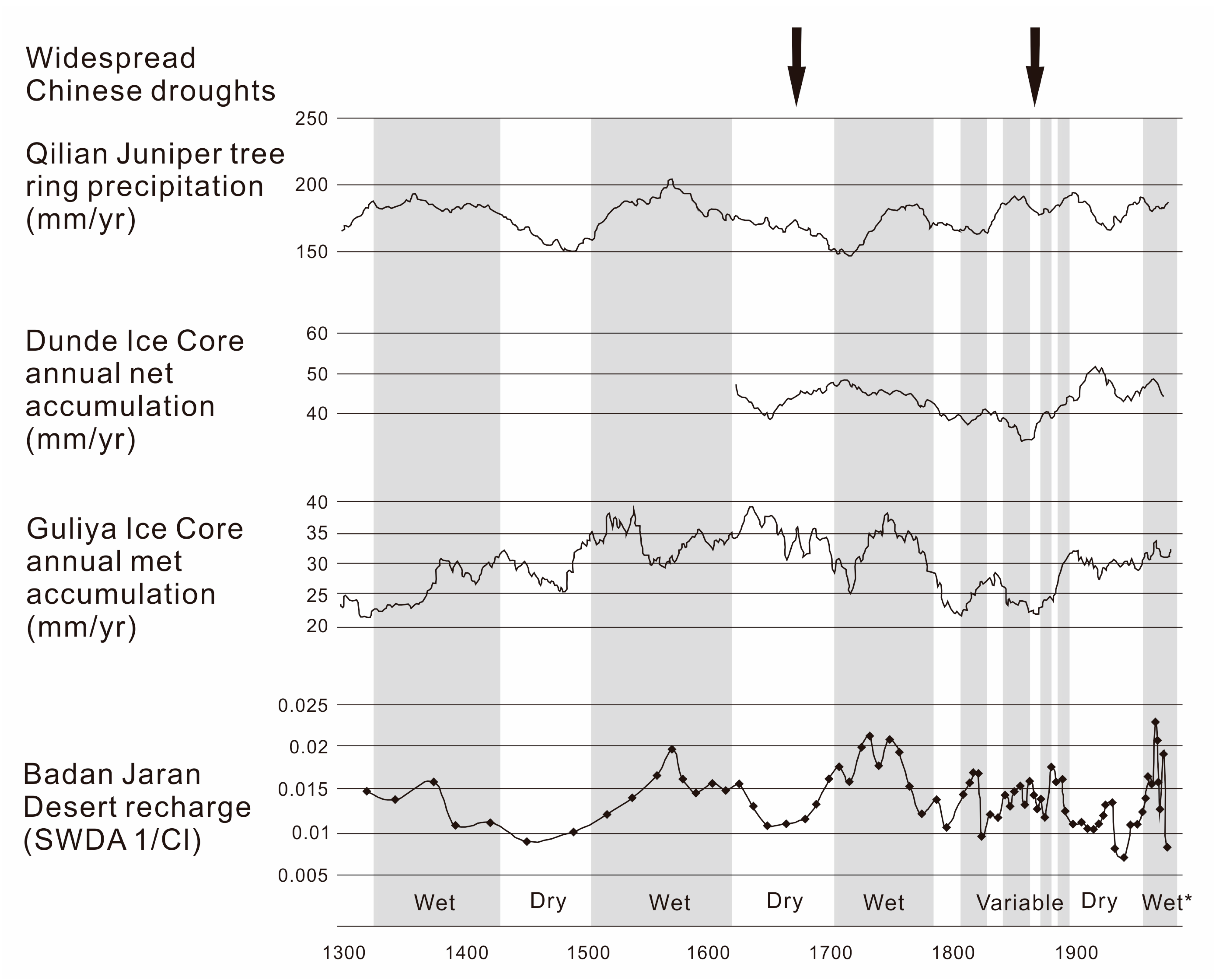
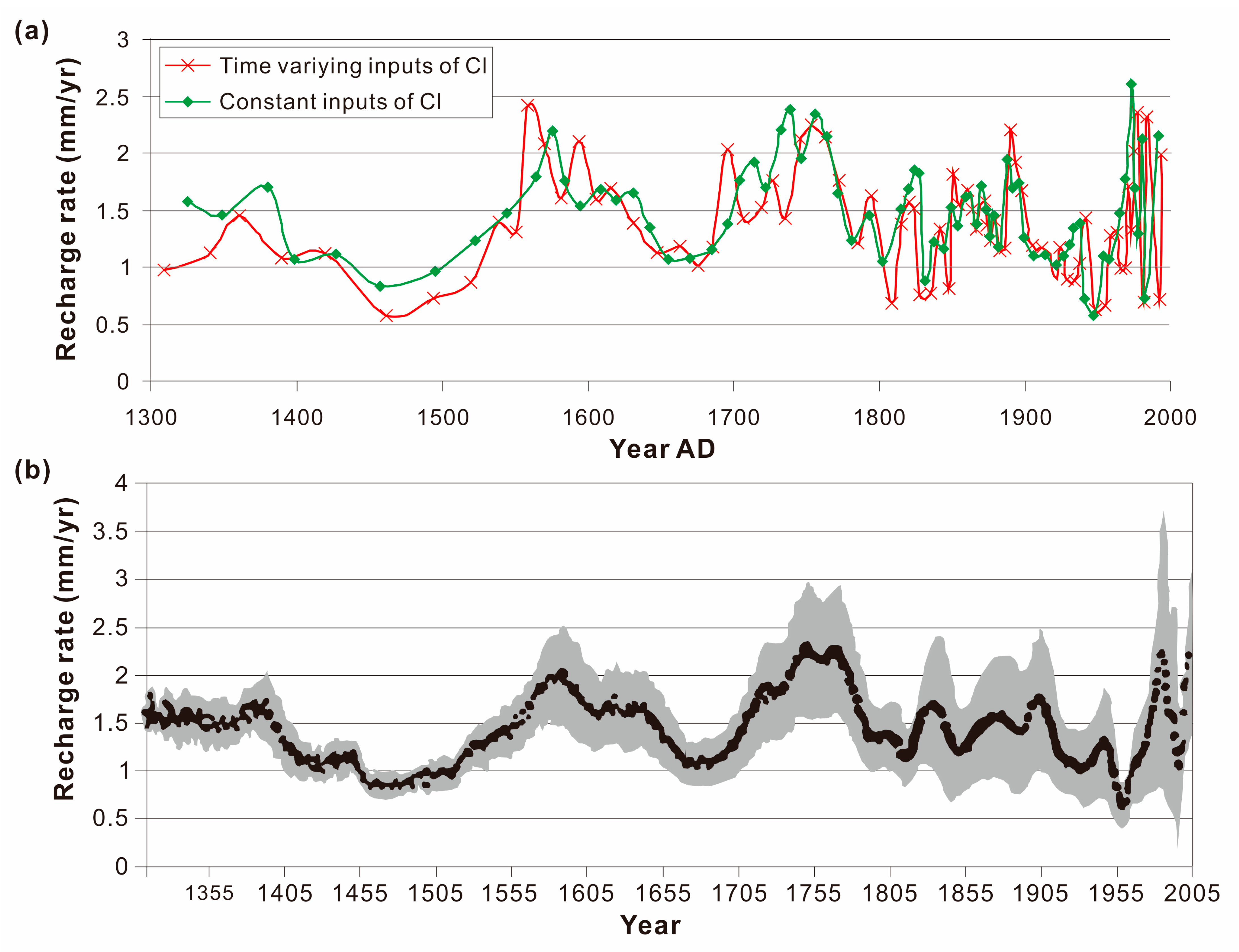
| Section ID | Section Position | Elevation/Altitude (m a.s.l.) | Groundwater Level (m) | Depth of Profile (m) | Mean Water Content (Dry Weight%) | Mean Cl Content (mg L−1) | Surface Cl Peak Value (mg m−2) | Chronological Dating (a) | Mean Recharge Rate (mm a−1) | References |
|---|---|---|---|---|---|---|---|---|---|---|
| Hinterland in the Badain Jaran Desert | ||||||||||
| SWDA | Sand dunes near Sayinwusu Lake | 1270 | ~30 | ~30 | 2.1% | 93 | 1526 | 681 | 1.35 | Reference [53] |
| SW1 | Sand dunes near Sayinwusu Lake | 1245 | / | 22.5 | 3.5 | 168 | / | 1185 | 0.95 | Reference [51] |
| BYBS | Sand dunes near Bayanor Lake | 1218 | / | 30 | 4 | 138 | / | 2050 | 0.91 | Reference [44] |
| BA1 | Sand dunes near Lake Bortolgoi | / | / | 7.4 | 7.0 | 100.4 | / | 520 | 1.33 | References [43,51] |
| BA 2 | Sand dunes near Lake Bortolgoi | / | 0 | 10 | 5.9 | 106.2 | / | 812 | 1.26 | References [43,51] |
| BYGS | Sand dunes near Wulanji Lake | 1255 | / | 10.5 | 1~2 | 589 | / | 1148 | 0.21 | Reference [46] |
| BYDS | Sand dunes near Wulanji Lake | 1203 | / | 10.5 | 1~2 | 213 | / | 572 | 0.59 | Reference [46] |
| BYES | Sand dunes near Wulanji Lake | 1309 | / | 10.5 | 1~2 | 232 | / | 584 | 0.54 | Reference [46] |
| BYFS | Sand dunes near Wulanji Lake | 1336 | / | 7 | 1~2 | 267 | / | 365 | 0.47 | Reference [46] |
| SH1 | Sand dunes near Lake Suhete | / | 0 | 10 | 3.5 | 120 | / | 876 | 1.11 | Reference [61] |
| SH2 | Sand dunes near Lake Suhete | / | / | 20 | 4.2 | 127 | / | 1660 | 1.05 | Reference [61] |
| BB1 | Sand dunes near Badain Jilin Temple | / | / | 20 | 1.9 | 165 | / | 1021 | 0.81 | Reference [61] |
| SWSA05-16 | Sand dunes near Sayinwusu Lake | 1219 | 0 | 16 | 2.4 | 120 | 5148 | ~300 | 1.12 | Reference [52] |
| SWSC05-10 | Sand dunes near Sayinwusu Lake | 1225 | 10 | 10 | 2.8 | 80 | 5190 | ~200 | 1.68 | Reference [52] |
| SWSD05-10 | Sand dunes near Sayinwusu Lake | 1260 | 50 | 10 | 1.9 | 111 | 7590 | ~180 | 1.2 | Reference [52] |
| SWSE05-10 | Sand dunes near Sayinwusu Lake | 1223 | 10 | 10 | 1.5 | 87 | 2189 | ~110 | 1.54 | Reference [52] |
| SWSF05-10 | Sand dunes near Sayinwusu Lake | 1233 | 20 | 10 | 2.2 | 103 | N/A | ~230 | 1.29 | Reference [52] |
| BASH05-10 | Sand dunes near Badan Lake | 1222 | 10 | 10 | 2.2 | 89 | 699 | ~230 | 1.50 | Reference [52] |
| BASI05-08 | Sand dunes near Badan Lake | 1209 | 0 | 8 | 2.8 | 76 | 1954 | / | 1.76 | Reference [52] |
| BASJ05-10 | Sand dunes near Badan Lake | 1222 | 10 | 10 | 2.8 | 164 | 9930 | ~200 | 0.82 | Reference [52] |
| BASK05-06 | Sand dunes near Badan Lake | 1201 | 5 | 6 | 1.9 | N/A | N/A | / | N/A | Reference [52] |
| BASM05-10 | Sand dunes near Badan Lake | 1287 | 80 | 10 | 2.2 | 111 | 5838 | ~200 | 1.20 | Reference [52] |
| BASN05-09 | Sand dunes near Badan Lake | 1282 | 70 | 9 | 2.1 | N/A | 27,753 | / | N/A | Reference [52] |
| BLSO05-07 | Sand dunes near Lake Bortolgoi | 1297 | 0 | 7 | 2.3 | N/A | 8105 | / | N/A | Reference [52] |
| BLSP05-10 | Sand dunes near Lake Bortolgoi | 1320 | 35 | 10 | 1.9 | 69 | 11,306 | ~130 | 1.92 | Reference [52] |
| BLSQ05-09 | Sand dunes near Lake Bortolgoi | 1320 | 35 | 9 | 2.3 | 97 | 12,729 | ~160 | 1.37 | Reference [52] |
| BLST05-10 | Sand dunes near Lake Bortolgoi | 1323 | 40 | 8 | 2.8 | 62 | N/A | ~130 | 2.16 | Reference [52] |
| YTSU05-09 | Sand dunes near Lake Yindertu | 1208 | 25 | 9 | 2.0 | 109 | N/A | ~270 | 1.23 | Reference [52] |
| NTSV05-10 | Sand dunes near Noertu Lake | 1221 | 40 | 9 | 1.8 | N/A | N/A | / | N/A | Reference [52] |
| NTSW05-10 | Sand dunes near Lake Yindertu | 1215 | 25 | 10 | 2.6 | 71 | N/A | ~210 | 1.88 | Reference [52] |
| Surrounding the Badain Jaran Desert | ||||||||||
| Beitu | Minqin Basin in Maowusu Sandy Land | / | / | / | 194 | / | / | 2.17 | Reference [39] | |
| TG-2 | North of Tengger Desert | / | / | 2.8 | 2.2 | 273 | / | 88 | 1.06 | Reference [41] |
| TG-3 | North of Tengger Desert | / | / | 17 | 2.5 | 193 | / | 663 | 1.49 | Reference [41] |
| WU-1 | Western edge of Tengger Desert (Wuwei) | / | / | 13.5 | 3 | 117 | / | 213 | 2.46 | Reference [41] |
| G1 | Loess Plateau (Ningxia Guyuan) | / | / | 14.25 | 17.3 | 7.7 | / | / | 100 | Reference [55] |
| G1-2 | Loess Plateau (Ningxia Guyuan) | / | / | 7 | 16.2 | 8.1 | / | 765 | 94 | Reference [56] |
| G2-1 | Loess Plateau (Ningxia Guyuan) | / | / | 11.25 | 15.2 | 13.9 | / | / | / | Reference [56] |
| G2-2 | Loess Plateau (Ningxia Guyuan) | / | / | 18.25 | 16.4 | 15.4 | / | / | / | Reference [56] |
| G3 | Loess Plateau (Ningxia Guyuan) | / | / | 7 | 9.5 | 89.1 | / | / | / | Reference [56] |
Disclaimer/Publisher’s Note: The statements, opinions and data contained in all publications are solely those of the individual author(s) and contributor(s) and not of MDPI and/or the editor(s). MDPI and/or the editor(s) disclaim responsibility for any injury to people or property resulting from any ideas, methods, instructions or products referred to in the content. |
© 2023 by the author. Licensee MDPI, Basel, Switzerland. This article is an open access article distributed under the terms and conditions of the Creative Commons Attribution (CC BY) license (https://creativecommons.org/licenses/by/4.0/).
Share and Cite
Zhu, B.-Q. Paleo-Atmospheric Precipitation Recharged to Groundwater in Middle-Latitude Deserts of Northern China. Atmosphere 2023, 14, 774. https://doi.org/10.3390/atmos14050774
Zhu B-Q. Paleo-Atmospheric Precipitation Recharged to Groundwater in Middle-Latitude Deserts of Northern China. Atmosphere. 2023; 14(5):774. https://doi.org/10.3390/atmos14050774
Chicago/Turabian StyleZhu, Bing-Qi. 2023. "Paleo-Atmospheric Precipitation Recharged to Groundwater in Middle-Latitude Deserts of Northern China" Atmosphere 14, no. 5: 774. https://doi.org/10.3390/atmos14050774
APA StyleZhu, B.-Q. (2023). Paleo-Atmospheric Precipitation Recharged to Groundwater in Middle-Latitude Deserts of Northern China. Atmosphere, 14(5), 774. https://doi.org/10.3390/atmos14050774




